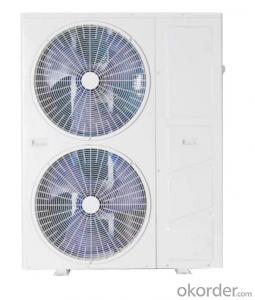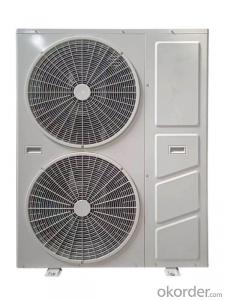Household ultra-low temperature air source heat pump unit 8P
- Loading Port:
- XINGANG
- Payment Terms:
- TT OR LC
- Min Order Qty:
- 5 watt
- Supply Capability:
- 500 watt/month
OKorder Service Pledge
OKorder Financial Service
You Might Also Like
●Bozhi air source heat pump 8P models, divided into 220V and 380V
●DC frequency conversion speed regulation technology
The use of DC frequency conversion compressor plus DC frequency conversion fan, according to user requirements can accurately adjust the running speed, efficient energy-saving, quiet and comfortable operation.
●Intelligent self-inspection and automatic early warning and repair
Automatic detection system running state, real-time algorithm analysis, and may foresee the problems of real-time intelligent early warning, avoidance, repair.
●Cloud platform expert hosting and remote control
The expert engineers can monitor, diagnose and warn the products in real time, and deal with them in time to keep the unit in good condition. Users can also remotely control the product through mobile phone APP on/off, operating mode, room temperature, etc.

- Q: Can an air pump be used for inflating air rafts with built-in sunshades?
- Certainly! An air pump is capable of inflating air rafts equipped with built-in sunshades. These particular air rafts are specially designed to be swiftly and effectively inflated using an air pump. The presence of the built-in sunshades does not hinder the inflation process and can be effortlessly managed during the air pump operation. To ensure correct inflation, it is crucial to adhere to the manufacturer's instructions and guarantee the compatibility between the air pump and the raft's valve system.
- Q: Can an air pump be used for inflating air mattresses with memory foam tops?
- Yes, an air pump can be used for inflating air mattresses with memory foam tops. Air mattresses with memory foam tops typically have an inner air chamber that can be filled with air using a pump. The memory foam top provides added comfort and support, but the inflation process remains the same as with regular air mattresses. It is important to choose a pump that is compatible with the valve on the mattress and has enough power to fully inflate it. Some air pumps even have specific settings for inflating air mattresses, making the process even easier.
- Q: Can an air pump be used for pumping gas?
- No, an air pump cannot be used for pumping gas. Air pumps are designed for inflating objects like tires or balloons by compressing and forcing air into them. On the other hand, gas pumps are specifically designed for pumping gasoline or other types of fuel into vehicles' fuel tanks. Attempting to use an air pump for pumping gas can be dangerous and potentially lead to accidents or damage to the pump and equipment. It is important to always use the proper equipment and follow safety guidelines when handling and transferring hazardous substances such as gasoline.
- Q: Are there any disadvantages of using an air pump?
- Yes, there are a few disadvantages of using an air pump. Firstly, air pumps can be noisy, which may cause disturbance in quiet environments or during nighttime. Secondly, some air pumps can consume a significant amount of electricity, leading to increased energy costs. Additionally, air pumps can sometimes produce vibrations that may be felt or heard, which can be bothersome. Lastly, certain types of air pumps require regular maintenance to ensure optimal performance, which can be time-consuming and add to the overall cost of using an air pump.
- Q: What kind of fish can live without inserting oxygen pumps?
- Small fish with a body length of less than 5 centimeters. As a peacock, black Marie, various Manlong, the ball can be. Especially the dragon fish and Manchester Chinese Betta, very resistant to hypoxia, but keep the two don't have other fish.The correct way to use an oxygen pump:Oxygen pumps do not open for 24 hours all day long! Usually in the morning, afternoon, each charge 2 hours or so, the evening charge for a while, if the weather is overcast, then open a longer time. If you do not have a filter, you should always change the water for the fish, preferably 3 or 4 days at a time, with 1/3 of the total water, but it must be dried! The temperature of the water should be similar to that of the fish tank! Every time you don't feed too much, clean up the excreta in the fish tank.
- Q: How does an air pump handle variations in altitude?
- The pressure generated by an air pump adjusts to accommodate variations in altitude, compensating for changes in atmospheric pressure. As one ascends, the atmospheric pressure declines, resulting in a reduced force propelling air into the pump. In response, the air pump augments its pressure output to ensure the desired volume of air is pumped. Conversely, when descending to lower altitudes with higher atmospheric pressure, the air pump reduces its pressure output to prevent overinflation or damage to inflated objects. The air pump's capacity to regulate pressure enables it to effectively manage altitude variations and sustain consistent performance, disregarding external atmospheric conditions.
- Q: Can an air pump be used for inflatable exercise equipment?
- Indeed, inflatable exercise equipment, such as stability balls, exercise mats, or yoga balls, can utilize an air pump for inflation. In fact, manufacturers often include their own dedicated air pumps with these items for convenient inflation. These specialized pumps are specifically crafted for use with inflatable exercise equipment and usually come with suitable attachments to ensure a secure and efficient inflation procedure. Nevertheless, it is crucial to consult the manufacturer's instructions or guidelines to confirm if your air pump is suitable for the particular type and size of inflatable exercise equipment you intend to use.
- Q: What are the different power consumption levels of air pumps?
- Air pumps can have different power consumption levels depending on their size, type, and intended use. The power consumption of an air pump is typically measured in watts (W) and can range from a few watts to several hundred watts. Small air pumps, such as those used in fish tanks or small inflatable items, usually have lower power consumption levels. These pumps typically consume around 1-20 watts of power, depending on their size and efficiency. They are designed to provide a steady flow of air while minimizing energy usage. Medium-sized air pumps, commonly used in larger aquariums or for inflating larger inflatable objects, may have power consumption levels ranging from 20-100 watts. These pumps are more powerful and can deliver a higher volume of air, making them suitable for larger applications. Large air pumps, often used in industrial settings or for specialized purposes, can have significantly higher power consumption levels. These pumps may consume anywhere from 100 watts to several hundred watts of power. They are designed to provide a substantial flow of air for demanding applications, such as aerating large bodies of water or operating heavy-duty machinery. It is important to note that power consumption levels can vary among different brands and models of air pumps, so it is always advisable to check the specifications provided by the manufacturer. Additionally, the actual power consumption of an air pump may vary depending on factors such as the operating conditions, air pressure requirements, and any additional features or settings used.
- Q: How does an air pump regulate airflow?
- An air pump regulates airflow by using a combination of valves and a motorized mechanism to control the amount of air being pumped into a system. The valves open and close to allow air to enter or exit, while the motor adjusts the speed and pressure of the pump to regulate the flow of air.
- Q: Are air pumps suitable for inflating air loungers for beaches?
- Air pumps are a suitable option for inflating air loungers at the beach. Inflating air loungers requires a significant amount of air, and using an air pump can expedite and simplify the process. There are various sizes and types of air pumps available, including manual foot pumps, electric pumps, and rechargeable battery-powered pumps. These pumps are designed to provide sufficient airflow and pressure to efficiently inflate air loungers. Additionally, they often come with different nozzle attachments that fit the air valve on the air lounger, ensuring a secure and airtight seal. Utilizing an air pump to inflate air loungers allows for time and effort savings, enabling a comfortable and relaxing experience at the beach.
Send your message to us
Household ultra-low temperature air source heat pump unit 8P
- Loading Port:
- XINGANG
- Payment Terms:
- TT OR LC
- Min Order Qty:
- 5 watt
- Supply Capability:
- 500 watt/month
OKorder Service Pledge
OKorder Financial Service
Similar products
Hot products
Hot Searches





















